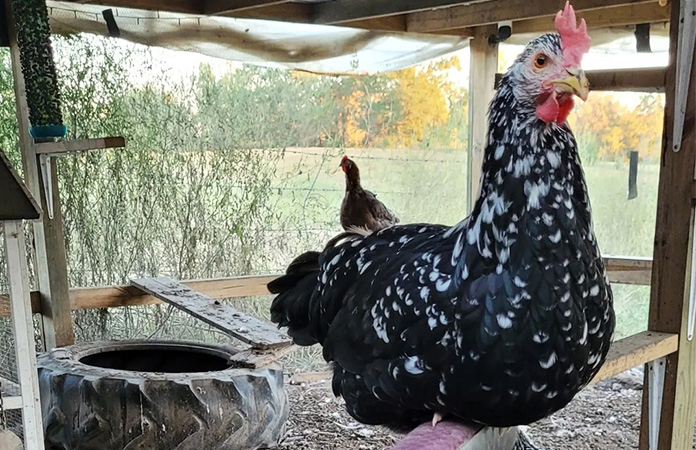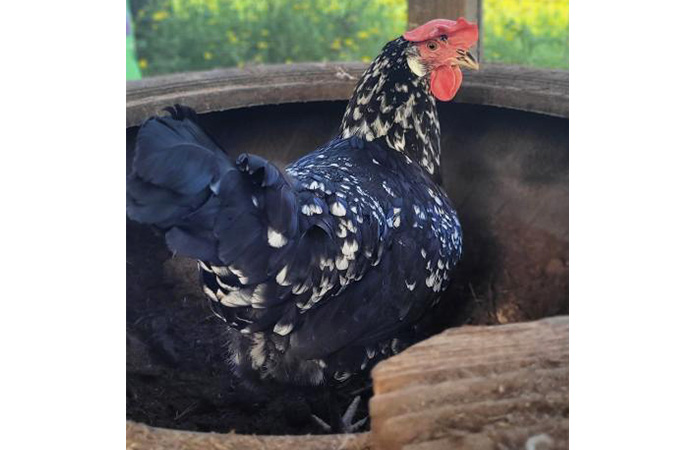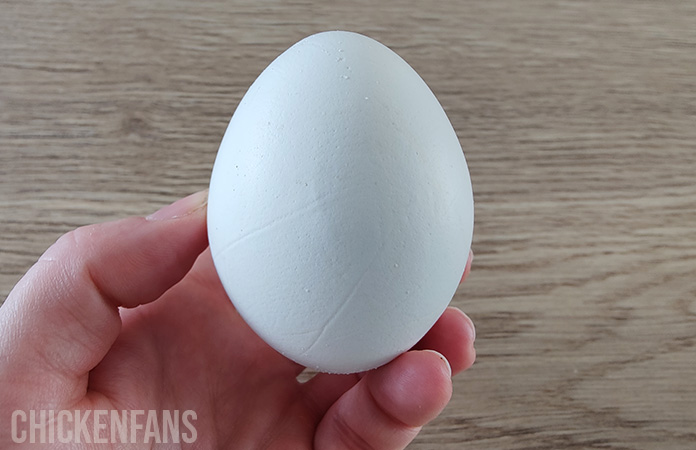Ancona Chicken: Why To Love This Italian Beauty

Looking to spice up your backyard with an exceptional breed? Look no further than the Ancona chicken! These Italian masterpieces are named after a picturesque seaport and will add a touch of charm to your flock.
Keep reading to discover some delightful details about these charming birds.
- Ancona hens lay up to 220 eggs yearly
- Meditteranean breed, so stands heat well
- Active chickens, love to free-range
- Seldom broody
| Eggs | Up to 220 eggs/year |
| Egg Color | White |
| Egg Size | Medium to large |
| Weight | 4.5 – 6 lbs |
| Hardiness | Cold & heat |
| Temperament | Friendly but active & vocal |
| Beginner-friendly | Yes |
| Color | Black mottled with white |
Characteristics
Anconas are a delightful sight! The piercing orange-red eyes peeking from the darker shade of black, with a touch of white distributed throughout, is a sight to behold. They have pale yellow skin with white earlobes. Yellow beaks and clear legs give a balanced contrast to the whole appearance.
They are not a big breed. Male Ancona chickens weigh about 6 lbs, while Ancona hens weigh about 4.5 lbs. They were developed by breeding multiple chicken breeds, including the Leghorn, creating a hardy breed and great egg-layer.
The Ancona chicken has a distinctive feather pattern. They can be seen in blue and red, but black is the most common.

These adorable-looking birds’ plumage has a touch of ‘v-shaped’ white at the ends. These mottled birds, when foraging in the sunlight, their plumage radiates a beetle green shade that will charm anyone.
Ancona chickens are found in two comb varieties; single comb and rose comb. They have medium to large combs, helping them regulate their body temperature in hot weather.
Their combs and wattles are red. In females, single comb slants towards one side and is considered the most beautiful.
Single-comb and rose-comb chickens do well in cold climates. If you are a breeder, the rose-comb chicken is your best choice. They are smaller in size and can withstand harsh winter days. However, it would be best if you kept an eye out for the single combs. They are vulnerable to frostbite.
Egg Production
As Ancona chickens were bred from Leghorns, it is no wonder they are loyal egg layers. These tough birds produce up to 220 medium to large white eggs yearly. Even in harsh cold weather, they are reliable layers. Moreover, pullets started laying eggs around the 5th month of age.
They are primarily used for egg production, which makes them not broody. If you want to keep these beauties for hatching, you need to fertilize the eggs in an incubator or look for more motherly chooks that will do the work for you.

Ancona chicks are the cutest, combining predominantly black back and pale yellow wings and belly. They tend to grow faster than other chicks but are small.
Personality
Ancona chickens are one of a kind. They are active, entertaining, happy, playful, and know how to keep themselves busy. You will find them clucking around all day. They have a wild touch to them but can be tamed easily.
Anconas are flighty chickens and, in some cases, real escape artists. They will easily flap, jump or fly over fencings. If you don’t want this to happen and you don’t want to free-range them, keeping them in a covered run is best.
They will get along with every chook in your backyard. These chickens are pretty talkative too, and some might say ‘loud’.
They are active and skilled foragers, resulting in not sitting in one spot for too long. These hyperactive birds also do not allow fellow chooks to monopolize one spot for too long. Being hyperactive does not mean they do not go along well with the flock.
These captivating beauties can develop a trusting relationship with their human families. You need to develop the connection from an early age.
You will find Anconas friendly and docile towards children. Making a relationship from the beginning instills animal care among the kids.
Ancona Breed Profile
These docile feathered beauties existed for centuries before being discovered by English poultry enthusiasts in 1850. Around the mid-nineteenth century, they ruled as a true Mediterranean breed. Late in 1888, they arrived in the US and became a popular breed. They are recognized as a heritage breed, and their status is considered ‘threatened’.
In early importation, their plumage was not uniform. By 1906, it became darker with uniform white ‘v-shaped’ markings at the end. The ideal distribution of white specks from one of five feathers is fascinating.
Ancona chickens were recognized by the American Poultry Association Standard of Perfection in 1898 for the single comb variety. Later in 1914, the rose comb variety was also included. They are amazing show birds and can dazzle the judges with their all-so-perfect looks!
They are believed to be bred with several breeds, including Leghorn chickens, and from there, they get the similarity in shape and size. In physical appearance, you will observe the difference between the shoulder and tail, where an angle can be seen when they join together.
As these amazing birds mature, they can be easily distinguished from the young ones. Their white mottle increases and indicates the aging effect.
The Ancona chicken was considered one of the prime egg producers in Europe. It is still popular in the U.S. and the UK but is rare in their native Marche region, Italy. In 2000, an initiative was taken to preserve biodiversity in the Marche region.
Summary
The Ancona chicken is a heritage breed originating in Italy and can be acquired through breeders and hatcheries. These beauties are loyal layers and produce up to 220 large white eggs per year.
They are docile, friendly, talkative, and entertaining but also flighty and active. Being a hardy breed, they can survive harsh weather easily. Their foraging trait is a blessing in disguise, and adding them to the flock brings out their captivating beauty.
If you want to learn more about chicken breeds that lay colored eggs, check out our article ‘10 Popular Chickens With Colored Eggs‘. Or go to our listicle breed summary on ‘The Classroom‘, or, if you’re unsure where to start, take a look at our ‘Chicken Breeds: Ultimate Beginners Guide‘.
Credits Featured Image: @brandy_l_m_ (IG)






















